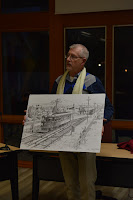The City of Snoqualmie Landmark Commission met on Thursday, January 25, 2018 to consider the nomination of car 523 to the Register. Car 523 was donated to the The Northwest Railway Museum in September 2017 and a $11,000 grant from 4Culture funded its move from Petaluma, California to Snoqualmie, Washington. The Museum prepared and submitted a nomination in fall 2017; this was the Commission's first meeting since. A Commission staff report was made, the Museum gave a presentation, and then the public was invited to comment.
 Historic Preservation architect Todd Scott is staff support for the King County Landmarks Commission (who sits as the Snoqualmie Commission when acting for Snoqualmie). He presented the staff report and called out more than a dozen communities in South King County once served by the Puget Sound Electric Railway and car 523. His report concluded with a recommendation to list car 523 on the Landmarks Register.
Historic Preservation architect Todd Scott is staff support for the King County Landmarks Commission (who sits as the Snoqualmie Commission when acting for Snoqualmie). He presented the staff report and called out more than a dozen communities in South King County once served by the Puget Sound Electric Railway and car 523. His report concluded with a recommendation to list car 523 on the Landmarks Register. Museum Executive Director Richard R. Anderson gave a short presentation on the 523 and commented on the car's role in the settlement and development of the White River valley. He went on to describe the extra-fare service offered using the parlor in the 523, and its popularity during the Alaska-Yukon-Pacific Exposition in 1909. (Check out this excellent University of Washington online exhibit too.) He also mentioned the important role of the Georgetown Steam Plant in powering a portion of the electric railway's third rail and overhead. And he introduced noted artist J. Craig Thorpe who has been commissioned to create an original artwork of car 523 departing the Auburn Depot. Mr. Thorpe unveiled the pencil sketch that was created to develop the concept and help finalize the exacting research that is being performed to create an accurate representation of a scene from the fall of 1915.
Museum Executive Director Richard R. Anderson gave a short presentation on the 523 and commented on the car's role in the settlement and development of the White River valley. He went on to describe the extra-fare service offered using the parlor in the 523, and its popularity during the Alaska-Yukon-Pacific Exposition in 1909. (Check out this excellent University of Washington online exhibit too.) He also mentioned the important role of the Georgetown Steam Plant in powering a portion of the electric railway's third rail and overhead. And he introduced noted artist J. Craig Thorpe who has been commissioned to create an original artwork of car 523 departing the Auburn Depot. Mr. Thorpe unveiled the pencil sketch that was created to develop the concept and help finalize the exacting research that is being performed to create an accurate representation of a scene from the fall of 1915.The City of Snoqualmie's Community Development Director Mark Hofman presented a letter from Mayor Matt Larson who wrote, "This artifact is highly relevant to one of the most compelling chapters in Snoqualmie's History . . . (among) the first customers of the electricity generated from the Snoqualmie Falls Power Plant was the Puget Sound Electric Railway cars . . . I believe the Puget Sound Electric Railway Car 523 will prove to be the most valued and popular artifact in the Northwest Railway Museum's collection. I support this effort without reservation."
Following the close of the public hearing, the Snoqualmie Landmarks Commission voted to approve the listing of car 523. It is a fitting tribute to a rare and representative object that retains a high degree of original integrity, and the listing will support the car's preservation. Stay tuned for progress as the Museum prepares to undertake significant rehabilitation and restoration of this unique resource.
Special thanks to the Landmarks and Heritage Commission, Historic Preservation Officer Jennifer Meisner, Historic Preservation architect Todd Scott, Snoqualmie Mayor Matt Larson, and artist J. Craig Thorpe for helping bring this nomination all together and making it a reality.








